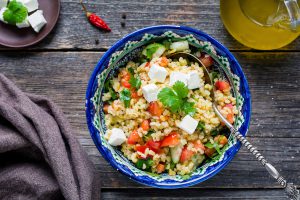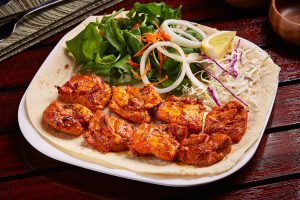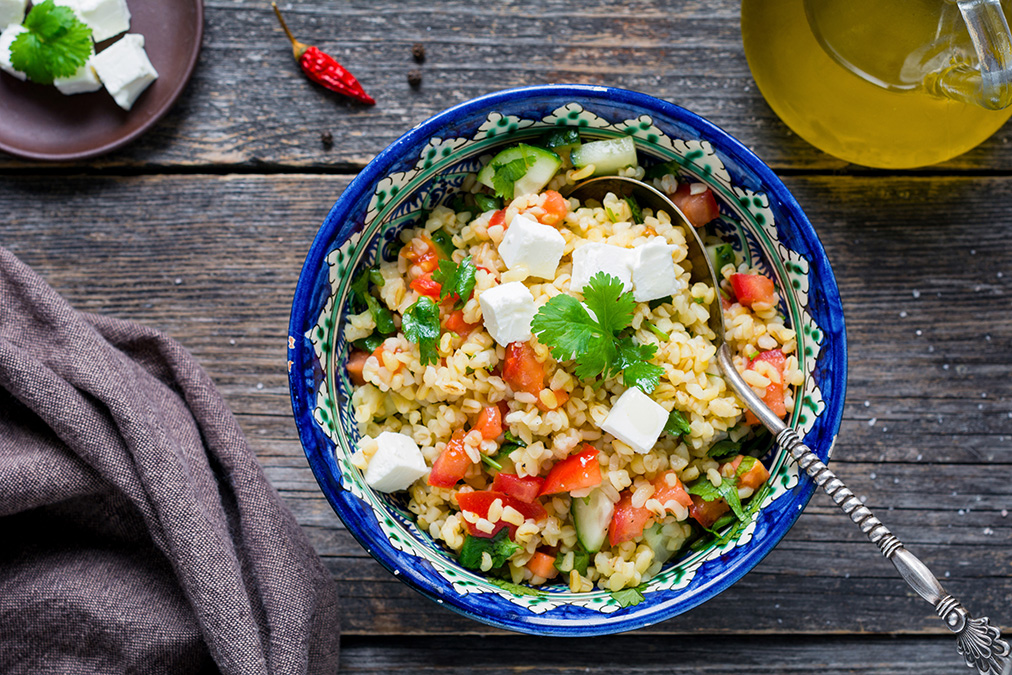The Mediterranean and Middle Eastern regions are close geographically, which has cultivated similarities in their cuisines over the centuries. Both diets heavily feature vegetables, fruits, whole grains, and nutritious fats from olive oils, nuts, and seeds, as well as less red meat than many other cultures. However, the two aren’t interchangeable — though they’re often confused with each other — and there are several differences that separate them.
Countries commonly associated with Mediterranean cuisine most often include those that border the Mediterranean Sea, such as Greece, Italy, Morocco, and Libya. Middle Eastern cuisine considers countries in West Asia, including Iraq, Yemen, United Arab Emirates, and Kuwait. Some countries, like Israel, Turkey, and Lebanon, straddle the line between the two regions and can be included in either.
Let’s take a look at the similarities and differences between these regions’ cultures and cuisines.
The Diet and Popular Dishes
There are several common dishes among Mediterranean and Middle Eastern cuisines, most notably favorites like hummus, falafel, tabbouleh (a bulgur wheat and herb salad), baba ghanoush (an eggplant dip similar to hummus), fattoush (a vegetable and pita salad), dolmas (stuffed grape leaves), and kebabs. The regions also share many staple ingredients, such as olive oil, lamb, chickpeas, pitas, pomegranate, eggplant, cucumber, parsley, cumin, and mint.
However, there are differences even within some of their similar dishes. For example, both have a meal that features sliced meat cooked on a vertical rotisserie and served on pita bread. However, a Mediterranean gyro is usually stuffed with tomatoes, red onions, and tzatziki (a sauce made with yogurt and cucumbers); Middle Eastern shawarma, on the other hand, is often topped with tahini (a condiment made from sesame seeds) and a variety of pickled fruits and vegetables.
While both regions are known for their spices, the types they use are different. The Middle East leans toward warm, earthy spices like harissa, anise, caraway, sumac, saffron, cardamom, and turmeric, as well as spice blends like za’atar and baharat. Mediterranean cuisine uses more sweet and aromatic spices, such as oregano, thyme, basil, coriander, paprika, fennel, tarragon, sage, and rosemary.
Another main difference is seafood. While lamb is a popular protein in both regions, the countries that border the Mediterranean Sea tend to include more seafood in their meals. You see this in dishes like paella, which often features fish, shrimp, mussels, or clams. Other popular seafood dishes are baked fish, niçoise salad, fried calamari, shrimp soup, and grilled scallops. Many types of seafood are also incorporated with pasta, another major part of the Mediterranean diet. Other key components of Mediterranean cuisine include tapas, pizza, salad, pilaf, and risotto.
For the Middle East, the increased use of legumes — such as lentils for soups and fava beans for dishes like ful mudammas — is a main factor that distinguishes its cuisine from the Mediterranean diet. People in the Middle East don’t consume as much pasta but instead favor grains like bulgur wheat, rice, barley, and wheat berries. You see this in traditional meals like mujaddara (cooked lentils and rice with caramelized onions and herbs) and kibbeh bil sanieh (a layered dish with ground meat, bulgar wheat, and spices).
Meal Practices and Eating Traditions
One popular style of eating in both the Mediterranean and the Middle East is meze. “Meze” comes from a Turkish word that means snack or appetizer. Similar to Spanish tapas, meze includes a variety of shared dishes with various flavors that complement each other. In the Middle East, breakfast and dinner are usually served in the meze style since lunch is the main meal for most of the region’s countries. In the Mediterranean, meze is more often used for appetizers, light meals, or entertaining. However, these uses can vary from country to country.
You’ll typically find a lot of dips, spreads, and other appetizer-like foods with pita bread to dip into the plates. Shared ingredients between the two regions can include fresh vegetables like carrots, bell peppers, and radishes; varieties of hummus; nuts; falafel; tabbouleh; baba ghanoush; cucumber and tomato salad; feta cheese or labneh (a soft cheese made from strained Greek yogurt); marinated olives; pickles; and dried fruits, such as dates, figs, or apricots, or fresh fruits, such as grapes, melons, or pears.
Some variations in a Middle Eastern meze may include tahini; Nabulsi cheese (a firm, brined white cheese) or chechil (a salty, smoky string cheese); kofta (skewers of ground beef and lamb mixed with parsley, onions, garlic, and warm spices); and spreads like muhammara (a roasted red pepper and walnut dip) or mutabal (a roasted eggplant dip). A Mediterranean meze could have tzatziki; baby mozzarella cheese or grilled halloumi; prosciutto or salami; and dips like beet tzatziki (a yogurt spread with puréed beets) or skordalia (a garlic-heavy potato purée).
Fun Fact
Baklava is a popular dessert in both the Middle Eastern and Mediterranean regions but with a key difference: The traditional Greek baklava is topped with a honey syrup, while the Middle Eastern variety uses a rosewater or orange blossom sugar syrup.
Sample popular Mediterranean and Middle Eastern dishes by following the recipes below:
 Greek Farro Salad
Servings: 6
Greek Farro Salad
Servings: 6
½ cup dry farro wheat 1 ½ teaspoons olive oil 1 ½ teaspoons unsweetened lemon juice 1 teaspoon honey ¾ cup cherry tomatoes, halved ¾ cup cucumbers, diced 2 ¼ tablespoons feta cheese, crumbled ¾ tablespoon fresh basil
STEP 1: To prepare the ingredients, chiffonade the basil by cutting into thin ribbons.
STEP 2: Bring a large pot of water to a boil, add the farro, and cook until done (20-30 minutes or until it’s tender but slightly chewy). Drain and chill rapidly until it’s ready to use.
STEP 3: In a small bowl, whisk together the olive oil, lemon juice, and honey. Set the dressing aside.
STEP 4: In a large bowl, toss the farro with the tomatoes and cucumbers. Sprinkle the feta and basil on top. Drizzle the dressing over the salad and toss lightly until the salad is coated.
 Chicken Tawook
Servings: 6
Chicken Tawook
Servings: 6
1 pound boneless, skinless chicken breast 3 ¾ tablespoons plain, low-fat yogurt 2 ⅛ teaspoons olive oil ¾ teaspoon fresh, peeled garlic clove, minced 1 ½ teaspoons unsweetened lemon juice 1 ⅛ teaspoons tomato paste ¼ teaspoon paprika ⅛ teaspoon fresh thyme, chopped ¼ teaspoon dried sumac, divided 1 tablespoon fresh parsley, chopped
STEP 1: Preheat the oven to 350°F.
STEP 2: To prepare the ingredients, trim the fat from the chicken breasts.
STEP 3: In a medium bowl, mix the yogurt, olive oil, minced garlic, lemon juice, tomato paste, paprika, chopped thyme, and half of the dried sumac.
STEP 4: Pour the yogurt mixture over the chicken and mix well. Cover with plastic wrap and refrigerate for 4 hours or longer.
STEP 5: Place the marinated chicken breasts on a lightly oiled sheet pan, being careful not to overcrowd the pan.
STEP 6: Roast the chicken for 40 minutes or until it reaches the proper internal temperature (165°F).
STEP 7: Remove the chicken from the oven and slice the breasts on the bias. Garnish with chopped parsley and the remaining sumac.







